What is the difference between choy sum and bok choy? This article is about bok choy vs choy sum.
Bok choy and choy sum are similar, which can cause some confusion for certain people, particularly my non-Asian readers. Therefore, I would take this opportunity to dive into this topic and provide details.
In addition, I will also discuss the proper way to cook these vegetables.
Let’s get into the nitty gritty of bok choy vs choy sum.
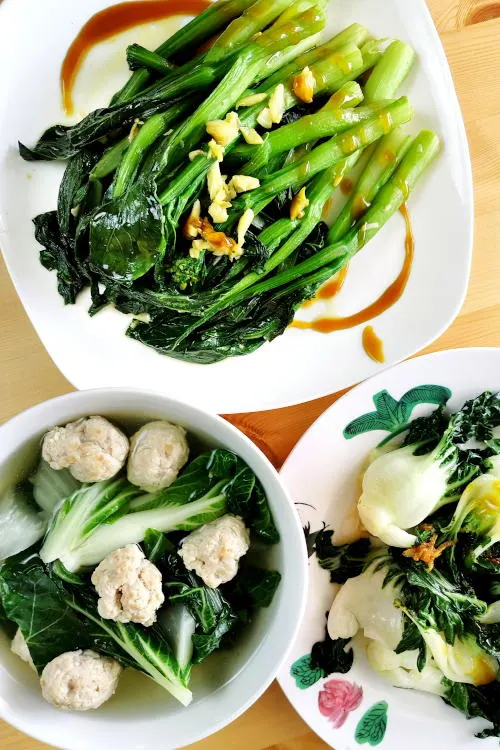
Note: This post may contain affiliate links. Please read my privacy policy for more info. I may receive commissions for purchases made through links in this post. As an Amazon Associate, I earn from qualifying purchases.
Bok choy
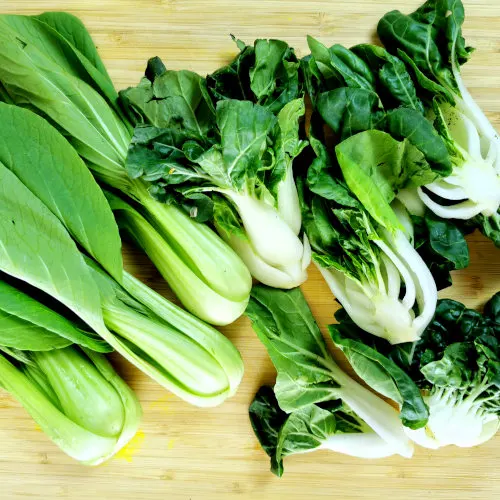
Bok choy is one of the most popular Asian greens in western countries. It is the sub-species Brassica rapa in the cabbage family.
Bok choy has different English names. Besides the ambiguous teme as ‘Chinese cabbage,’ it also spells as bok choy, pak choi, pok choi, bok choi, and pak choy. They are all referred to as the Chinese words ‘白菜’, which means white vegetable in Cantonese.
Bok choy has white stalks (some come with light green stems) and dark green leaves. It has a high content of water, about 95%, which make the stem crunchy and juicy. The leaves have a slightly bitter flavor.
It is rich in vitamin a, vitamin c and vitamin k, vitamin b6, and calcium.
Besides choy sum and bok choy, gai lan (Chinese broccoli) and napa cabbage are among the most common Asian leafy greens outside Asia. It is available in most Asian grocery stores.
Choy sum
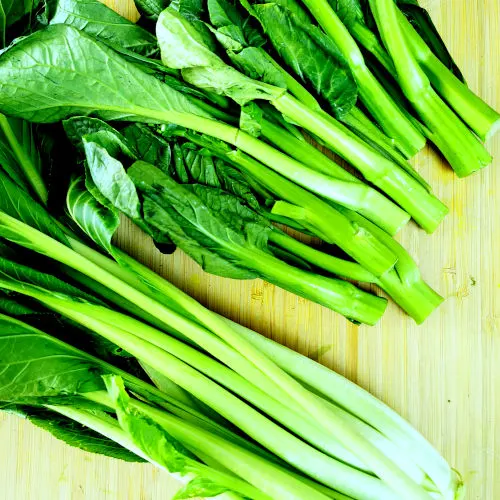
Choy sum belongs to the genus Brassica of the mustard family.
It also spells as choi sum, choi sam, and caixin besides choy sum. All the translations referred to the Chinese name 菜心, which means ‘the heart of the vegetable.’ It is the most common vegetable used in Chinese cuisine.
Choy sum looks similar to gai lan (Chinese broccoli) but with unique tiny yellow flowers at the tip. It is also called Chinese flowering cabbage.
The stems are long and straight, with light green color and a crunchy texture. The leaves are large, dark green with a mildly bitter taste.
There are different varieties of choy sum. My preference is the smaller one called Hong Kong choy sum, which has relatively short stems and is less fibrous.
How to prepare choy sum and bok choy for cooking?
Choy sum
Since choy sum comes in different sizes, there is some minor difference in how they are prepared.
The outer layer of the stem is fibrous for both small and large choy sum. Use a vegetable peeler to peel off the outer layer until it reveals the lighter color flesh beneath.
Snap to separate the stems and leaves of the bigger choy sum. Cook the stems as they are tougher, followed by the young leaves, which are more tender.
Bok choy
Bok choy has no visible fibrous layer on the surface, so peeling off the surface layer is unnecessary.
There is no need to cut the small bok choy as they have tender leaves and crunchy stalks. However, you can cut them lengthwise to reveal the beautiful layers of the stem, which is quite common to double up as garnish in Chinese cuisine.
Larger bok choy has thicker stems than choy sum. It is more fibrous and therefore is best for making soup. You can cut the thick stems on the bias into half-inch sections for stir-frying. Short sections of the large stems take less time to stir-fry until crisp-tender.
How to cook choy sum and bok choy
In Chinese cooking, there are three common ways to cook bok choy and choy sum.
Method 1: blanch the vegetables
The simplest method is to blanch the bok choy in salted water with some vegetable oil. Bring a pot of water to a boil, add some salt (more is OK, like cooking pasta), and a tablespoon of vegetable oil. Place the vegetables in the water and blanch for a few minutes.
The leafy part is cooked when the white stems turn crisp-tender. When it is done, remove and drain, then dress with soy sauce, oyster sauce, shallot oil, or their combination to serve.
Some people are concerned blanching the bok choy will destroy the vitamins and other nutritional elements. However, you can get around it by steaming the bok choy until crisp-tender. In this case, you will need more dressing as the vegetables are not seasoned with salt and oil.
This method is the simplest form of cooking Asian vegetables. We called it yu choy sum 油菜心 in Chinese, meaning simply cooking vegetables with oil.
Method 2: Stir-fry with chopped garlic
The second method is to stir-fry the bok choy. Saute garlic with oil, then place the bok choy into the oil over high heat and stir-fry. The leaves will wilt when it’s heated. Then season with salt and dish out when it turns aromatic.
Dress the vegetable with some shallot oil and oyster sauce to serve for the best result.
Method 3: Make vegetable soup
The third method is to make a bok choy soup. It is commonly prepared in the typical Cantonese family for a simple meal. Usually, the stock is either homemade chicken stock or anchovy stock. Pork slices and pork balls are also widely used to flavor the soup. When I was young, my mom used to cook pork loin slices (she is quite a health freak) in boiling water and include a few fresh ginger slices. Then she will add the bok choy to simmer for a few minutes. This method produces the tasty bok choy soup in the simplest form.
Note:
Bok choy comes in different sizes. The baby bok choy is the best, in my opinion. It has a crunchy stem that is not fibrous. It is also more flavorful than the large one.
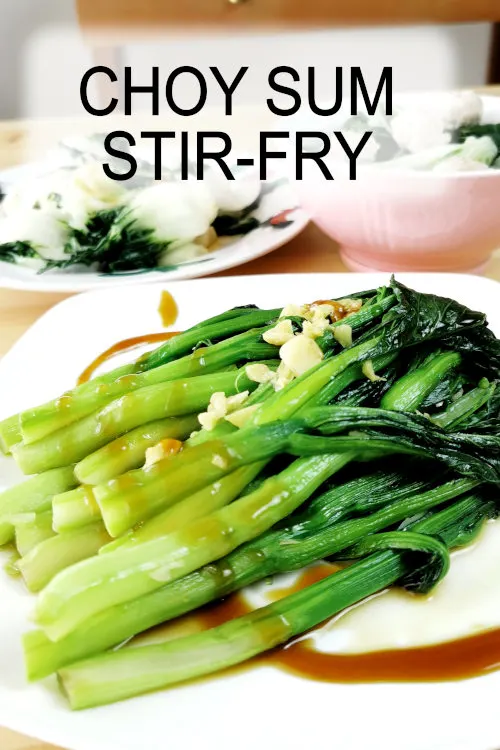
How to keep these vegetables?
Freshly purchased bok choy and choy sum can last for a week with proper storage. I use two methods, and both work well.
The first method is to keep them in a plastic or ziplock bag but not close them entirely to leave some space for air exchange as the vegetables are alive.
The second method is to roll up the bunch of vegetables with newspaper. This method is handy for keeping the large bok choy or choy sum that cannot fit into the bag. The paper also helps to absorb the moisture, especially if the vegetables are wet.
Keep the vegetables in the vegetable storage section of the refrigerator.
Other Asian vegetable dishes for you
If you like this bok choy vs choy sum article, you will probably also like other Chinese vegetables.
- Buddha’s delight. Not a leafy vegetable dish but is a hugely popular braised vegetable dish among the Chinese. This recipe is authentic Chinese cuisine with no other similar dishes coming near.
- Beancurd skin with mushroom. Bean curd skin is seriously an Asian specialty. Try this recipe to appreciate authentic Chinese cuisine. You can get beancurd skin in most Chinese grocery stores or Asian markets.
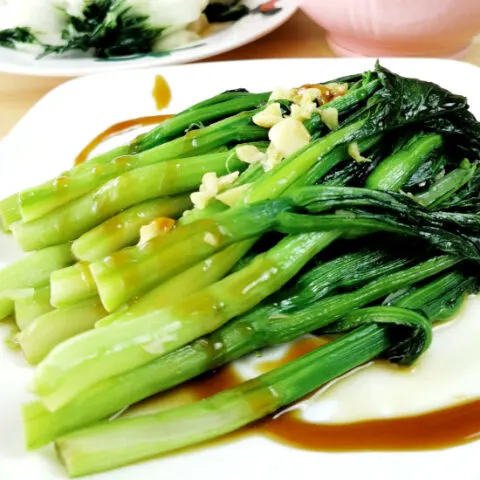
Choy sum stir-fry with garlic
Quick and easy choy sum stir-fry with garlic. Dressed with shallot oil and oyster sauce.
Ingredients
- 400g Hong Kong choy sum
- 2 tbsp vegetable oil
- 1 tbsp chopped garlic
- 1/2 tsp salt
- 1 tsp shallot oil
- 1 tbsp oyster sauce
Instructions
- Wash the choy sum, and peel off the fibrous outer layer of the stalk with a vegetable peeler.
- Snap to separate the stem and the leaves.
- Heat the vegetable oil in a wok, and saute the chopped garlic until aromatic.
- Add the choy sum stalks, and stir-fry for a minute.
- Include the more tender stalks and leaves. Add 2 tbsp of water to stir-fry until the leaves are wilted.
- Add a quarter cup of water, and simmer over medium heat until the vegetable becomes crisp-tender.
- Arrange the choy sum on a serving plate.
- Drizzle the shallot oil and oyster sauce on top to serve.
Notes
Use the ‘vegetarian’ oyster sauce for a truly vegetarian dish.
Recommended Products
As an Amazon Associate and member of other affiliate programs, I earn from qualifying purchases.
Nutrition Information:
Yield: 3 Serving Size: 1Amount Per Serving: Calories: 145Total Fat: 14gSaturated Fat: 1gTrans Fat: 0gUnsaturated Fat: 12gCholesterol: 0mgSodium: 598mgCarbohydrates: 4gFiber: 1gSugar: 1gProtein: 2g
This data was provided and calculated by Nutritionix on 7/8/2022



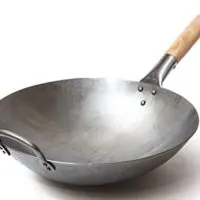
Tina
Monday 8th of August 2022
Love the video, I wanted to cook different vegetables.
KP Kwan
Monday 8th of August 2022
Hi, this is KP Kwan. I am happy to see you in this comment area, as you have read through my recipe. I am glad to reply to any questions and comments as soon as possible.